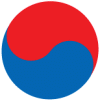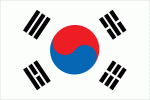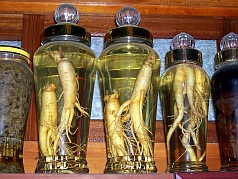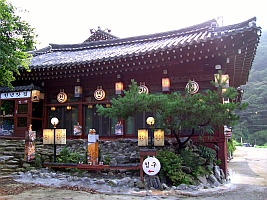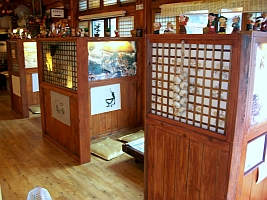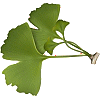
South Korea
Informations
South Korea is a well economically developed country mainly through its "chaebols", major corporations, like Lotte, LG, Hyundai, Daewoo, Kia, or Samsung which name means "three stars". Most of them have a strong presence in Europe.
The Korean alphabet, hangeul, is one of the most logical (if not he best) in the world. It was created during the 15th century. Phew ! no need to
deal with the ideograms but beaware, beyond basic formulas, the korean language is often considered as one of the most complex Asian
languages, particularly because of its politeness forms. While there is only one in english (if we except speaking to God), only two in
french or spanish... there are at least 7 which are fairly commons in korean. However the latin alphabet is often used on the road signposts,
partly because of the strong U.S. military presence.
South Korea is indeed still officially at war with neighboring North Korea. The same people was divided by the end of world war II. After the
capitulation of the Japanese invaders who occupied the whole Korea since 1910. The northern part is under the influence of Communist China
whereas South Korea is under the capitalist influence of the United States. In 1950 North Korea invaded the country to achieve unification in its favor.
Taken by surprise, South Korea was almost fully occupied when the United States and its allies got a UN mandate (Russia had practiced
empty chair policy) to intervene. The Chinese intervention stopped the counter offensive in 1953 at the 38th parallel, which became the
border and a UN demilitarized zone (although this may be one of the most militarized in the world in practice).
Let's note the hospitality of the Koreans who will spontaneously give you a help if you seem to have lost your bearings, the very good network of buses, and the KTX which is actually the (french) TGV. And let's add that Korean society is arguably the most Confucian in the world (get informations about Confucianism on travelogue China page Shanghai - Confucius temple). What could seem to be paradoxical as Koreans are also regarded as the "Latins" of Asia. And to release the pressure, they will have a glass of soju or a beer in the evening (always with a meal or snack) and then they will go and sing in a nolaebang (which is the Korean name for karaoke). It is worth trying if you go to Korea as it is quite effective to unwind. Another thing that is worth giving a try is : sauna (jiljibang) where you can stay all day and spend the night in an "alcove".
General information about "the land of the morning calm"
|
Motto : none official
|
Anthem : Aegukga (the song of love for the country)
(source : http://www.flaggen-server.de/main/main.php) |
|
Symbol : Taegeuk
Note : the hibiscus is the national flower. As it is resistant to insects, it symbolizes the stamina of korean people.
|
Flag :
The taegeukki is the name of the korean flag. On a white background (land, nation), it combines the circle (symbol of infinity that represents the people here)
to the taegeuk and to 4 of the 8 -Taoist- palgwe (top left then clockwise : Heaven, Water, Earth and Fire).
White is also a symbol of peace. |
|
Capital : Seoul
"the capital of the land of the morning calm" -actually no surname for the capital but only for the country- Landmark : Namdaemun gate |
Population :
48.5 Millions inhabitants (2009)
(11 Millions in Seoul and more than 22 millions with the outskirts) |
|
Area : 99 720 km2 (38,500 square miles)
|
Currency : Won
|
|
Religion :
|
Political system : Republic
|
|
Official language : Korean
|
Time zone : UTC +9h
(from United Kingdom : + 8h in summer and + 9h in winter) |
|
Architectural styles :
|
Folklore and traditions :
|
|
Culinary specialities :
|
|
|
Drink :
|
|
|
|

